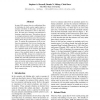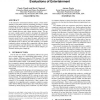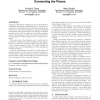486 search results - page 14 / 98 » What Makes Process Models Understandable |
ACMDIS
2004
ACM
14 years 1 months ago
2004
ACM
The success of translating an analog or manual practice into a digital interactive system may depend on how well that translation captures not only the functional what and how asp...
MM
2009
ACM
14 years 2 months ago
2009
ACM
Popular content in video sharing web sites (e.g., YouTube) is usually duplicated. Most scholars define near-duplicate video clips (NDVC) based on non-semantic features (e.g., di�...
EMNLP
2010
13 years 5 months ago
2010
In many NLP systems, there is a unidirectional flow of information in which a parser supplies input to a semantic role labeler. In this paper, we build a system that allows inform...
FDG
2009
ACM
14 years 2 months ago
2009
ACM
As the interactive entertainment industry matures, a better understanding of what makes software entertaining is needed. A natural starting point is the application of traditional...
ITICSE
2003
ACM
14 years 29 days ago
2003
ACM
Changing conditions for teaching increase our motivation to understand the teaching and learning process. First time investigators of educational settings often feel uncertain abo...



